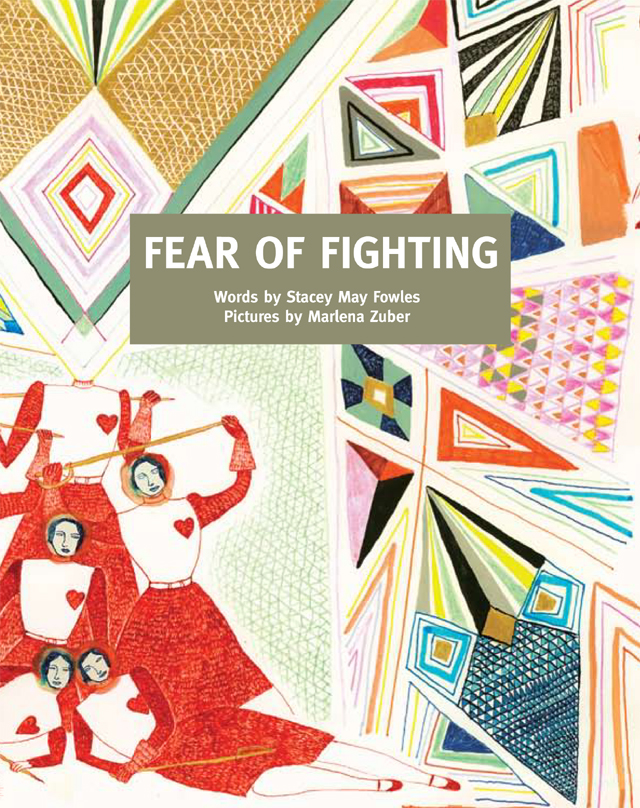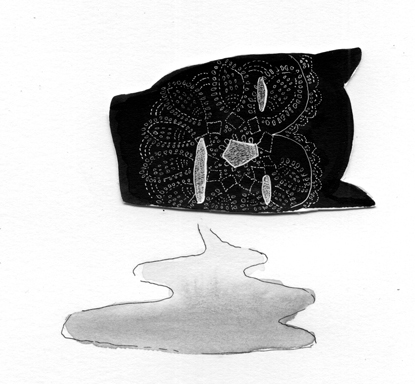TDR
Interview: Stacey May Fowles
by Katelynn Schoop
 As
the graphic novel moves toward the mainstream, it similarly becomes an
accessible method of articulating and making public issues that require
a voice. As
the graphic novel moves toward the mainstream, it similarly becomes an
accessible method of articulating and making public issues that require
a voice.
With the publication of Fear of
Fighting, novelist and publisher of Shameless magazine Stacey
May Fowles addresses the often-silenced world of mental illness, and the
sense of alienation and loneliness that accompanies it.
In bringing together Fowles’ prose
with the illustrations of Marlena Zuber the graphic novel, published by Invisible
Publishing, emerges as a new kind of urban story – describing a
life that may actually be lived by many.
Fear of Fighting launches on
Tuesday, October 14 at The Gladstone Hotel 1214 Queen St. West, Toronto,
at 730pm.
[October 2008]
*
Katelynn Schoop: This is sort of an
obvious question, but: how did you end up writing a graphic novel?
Stacey May Fowles:
It was a complete fluke, actually. Invisible Publishing had expressed
some interest in doing a book with me after I'd been a contributor to
one of their early anthologies, and I had set up a meeting with their
publisher Robbie MacGregor to discuss doing a short story collection or
my second novel with them. On the way to the meeting, I picked up some
drawings that Marlena Zuber had biked over to my apartment building. She
and I had been working on a collaborative piece for an anthology, and I
just happened to bring some of the resulting drawings to the meeting
with Robbie. There I was pitching him hundreds of manuscript pages over
perogies, and he fell in love with a few drawings I'd brought along by
accident. It was pretty amazing how much faith he had in us right from
the beginning. He made a huge, enthusiastic commitment to the project
after seeing only a few pages of the work we had done together, a
collaboration that was still really fresh at the time. I walked out of
that meeting, called Marlena on my cell phone while I was still on the
street and said "hey, you wanna do a book with me?" and she
said yes right away.
 KS:
Was the writing process radically different from writing a novel? KS:
Was the writing process radically different from writing a novel?
SMF:
The major difference for me was that I wasn't submitting a finished
manuscript hoping it would be accepted, I was creating something with
another person with an end in sight. That experience can be
simultaneously exciting and terrifying. You've got the confidence of
publication and someone's faith in you on your side, along with all the
benefits of a creative partner to support and buoy you, but the pressure
of a deadline can be overwhelming. I'll admit that there were days when
the pressure was crippling and nothing would come. Having said that,
working with a partner on something both visual and literary really
refreshes your creativity and revives your interest in the craft. If
anything it was much more fun to send Marlena a batch of copy and see
what she did with it creatively, rather than sitting day in and day out
in a lonely room working away in a vacuum. Her visual reactions to my
prose were always an inspiring way to propel me to keep working.
KS: How did you end up collaborating
with Marlena Zuber, and what was it like to work on a book with multiple
people (be honest)?
SMF:
Back in the days when I had a day job, Marlena and I shared desk space
at Creative Works Studio, an art and vocational studio for people with
long term mental health issues run by St. Michael's Hospital in Toronto.
I was the administrative assistant and she was a vocational arts
councillor, and we always talked about working collaboratively (and in
some ways we already were). The graphic poem we did for Boredom
Fighters! (Tightrope Books) was the first piece we worked on together,
and we both really enjoyed the process, so doing a book length work
seemed a natural progression. We worked together well as colleagues,
became friends, and the creative collaboration (which came a few years
later) always seemed like the bonus super fun part of our relationship.
Because we worked in the field of mental health together, and because
the program we worked on was focused on community, both of those themes
seemed a natural fit in our work.
You would assume that working with
multiple people would be much more difficult, but with Marlena the
process of creating a book was so much easier. She's one of the most
supportive, committed and genuine people I've ever met, and she was
ridiculously respectful of my writing even when it meant illustrating it
was difficult. When I would offer to change certain passages to
facilitate her role she'd always respond with a flat out no. It's a
truly amazing experience for a writer to work with an illustrator and
I'd certainly recommend it. Marlena made me see things in my writing
that I didn't even know were there, and she turned the world of Fear of
Fighting into something surreal, imaginative and beautiful.
That and she invites me over for
margaritas and gives the best Christmas and birthday gifts.
KS: Like your first novel, Be Good, the
graphic novel centers on being alienated, lonely, and twenty-something
against the urban landscape. Do these themes recur in your work
deliberately – as in, this is something that needs to be articulated?
SMF:
I'm on the edge of thirty now, so maybe I won't be able to articulate
the alienated twenty-something experience properly for that much longer,
if I ever did all - maybe my next book will be about married home-owners
who enjoy gardening and take daily vitamins.
I've said in the past that I feel like
there's a tendency in mainstream literature (and pop culture in general)
to parody young women, their lives, and their sexuality, turning them
into boy crazy, shoe-obsessed, martini-gulping cartoons. Thankfully, I
think more and more we're seeing younger female writers who are working
from their experience, writing truly honest, relevant narratives that
are not limiting and that are gaining more attention and respect in the
media. In Fear of Fighting I wanted to look at how urban alienation and
loneliness can translate into mental health issues, specifically anxiety
disorder, a condition that's common in the city amongst people in their
mid to late twenties but rarely discussed or treated. I feel like
Marlena really understood this need to get these ideas out there, and
that her illustrations really articulate the condition in a way where
words would fail. I don't think the compulsion to write about these
issues is a new one, but I think that it wouldn't be wrong to say that
popular Canadian literature doesn't make a lot of room for young, urban
women's stories. I feel like the more we write and support them, the
more people will pay attention. |
